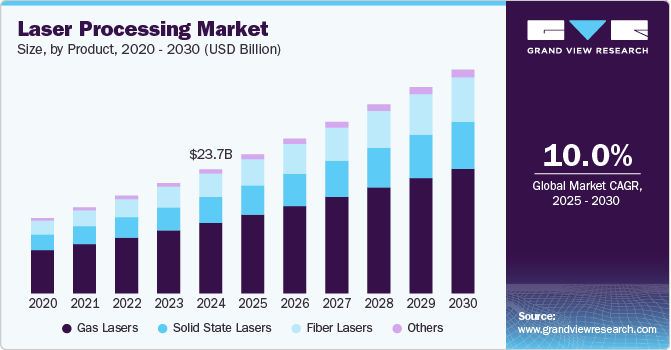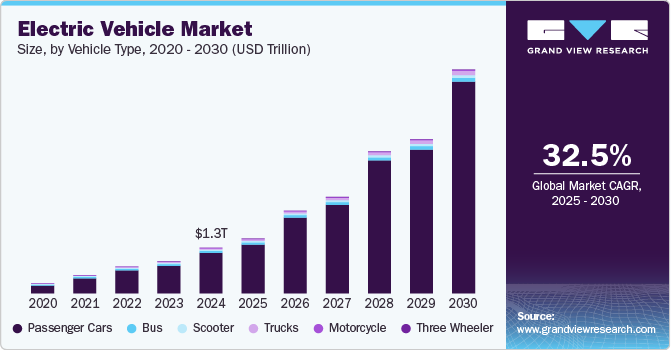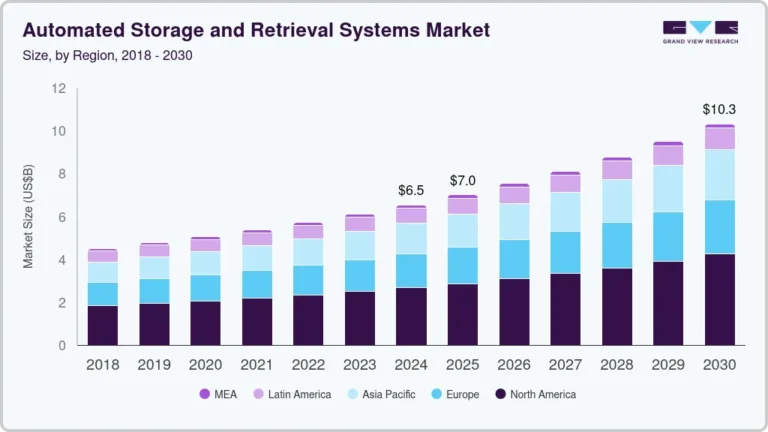Laser Processing Market Size, Share & Trends Analysis growing at a CAGR of 10% from 2025 to 2030

The global laser processing market size was estimated at USD 23,694.8 million in 2024 and is projected to reach USD 42,728.9 million by 2030, growing at a CAGR of 10% from 2025 to 2030. Laser processing is vital in additive manufacturing, particularly in selective laser melting (SLM) and laser sintering for metals and high-performance polymers.
Key Market Trends & Insights
- In terms of region, Asia Pacific was the largest revenue generating market in 2024.
- Country-wise, South Korea is expected to register the highest CAGR from 2025 to 2030.
- In terms of segment, gas lasers accounted for a revenue of USD 15,043.6 million in 2024.
- Fiber Lasers is the most lucrative product segment registering the fastest growth during the forecast period.
Market Size & Forecast
- 2024 Market Size: USD 23,694.8 Million
- 2030 Projected Market Size: USD 42,728.9 Million
- CAGR (2025-2030): 10%
- Asia Pacific: Largest market in 2024
Request a free sample copy or view report summary: https://www.grandviewresearch.com/industry-analysis/laser-processing-market/request/rs1
These techniques allow manufacturers to create complex, lightweight parts layer-by-layer, which is especially valuable in the aerospace, automotive, and medical sectors. The precision of lasers ensures high-quality builds with minimal waste and enables rapid prototyping and customization. As 3D printing becomes more widely adopted, the role of laser processing in additive manufacturing will continue to expand.
The renewable energy sector, especially solar panel manufacturing, has begun to adopt laser processing for its precision and ability to enhance energy capture efficiency. Laser scribing and cutting are used in photovoltaic cell manufacturing, enabling higher panel efficiency by creating finer and more precise structures. Additionally, lasers assist in the production of energy storage devices, such as lithium-ion batteries, which are essential for renewable energy storage. This trend is expected to grow as renewable energy gains importance globally, driving demand for high-precision laser solutions.
The rising demand of Industry 4.0, laser processing systems are increasingly integrated into automated production lines, improving efficiency and consistency. In smart factories, lasers contribute to high-speed, precise operations that minimize human intervention, supporting scalable and cost-effective manufacturing. Automated laser processing systems are designed to be more adaptable and reliable, reducing downtime and enhancing production throughput. As industries adopt more automation, the demand for laser processing technology compatible with IoT and smart systems will expand.
The electronics industry is a major driver of the market, especially in areas requiring precise cutting, engraving, and marking. With the rise in demand for miniaturized electronic components, lasers offer unparalleled accuracy for intricate designs. This is particularly critical for smartphones, wearables, and microchips, where laser-based methods enhance efficiency and product reliability. As manufacturers aim for smaller and more complex devices, the adoption of laser processing in electronics is expected to increase.






